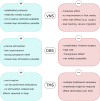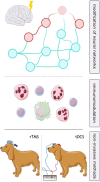Neurostimulation as a Method of Treatment and a Preventive Measure in Canine Drug-Resistant Epilepsy: Current State and Future Prospects
- PMID: 35782557
- PMCID: PMC9244381
- DOI: 10.3389/fvets.2022.889561
Neurostimulation as a Method of Treatment and a Preventive Measure in Canine Drug-Resistant Epilepsy: Current State and Future Prospects
Abstract
Modulation of neuronal activity for seizure control using various methods of neurostimulation is a rapidly developing field in epileptology, especially in treatment of refractory epilepsy. Promising results in human clinical practice, such as diminished seizure burden, reduced incidence of sudden unexplained death in epilepsy, and improved quality of life has brought neurostimulation into the focus of veterinary medicine as a therapeutic option. This article provides a comprehensive review of available neurostimulation methods for seizure management in drug-resistant epilepsy in canine patients. Recent progress in non-invasive modalities, such as repetitive transcranial magnetic stimulation and transcutaneous vagus nerve stimulation is highlighted. We further discuss potential future advances and their plausible application as means for preventing epileptogenesis in dogs.
Keywords: deep brain stimulation; dogs; drug-resistant epilepsy; epileptogenesis; seizure; transcranial magnetic stimulation; vagus nerve stimulation.
Copyright © 2022 Nowakowska, Üçal, Charalambous, Bhatti, Denison, Meller, Worrell, Potschka and Volk.
Conflict of interest statement
GW has rights to receive future royalties from the licensing of technology to Cadence Neuroscience Inc, and has received research support from Medtronic, LivaNova, and was previously on the scientific advisory board of NeuroPace Inc. HV served as paid consultant in the field of epilepsy for Boehringer Ingelheim, CEVA animal health, Nestle Purina and served as contract researcher for: Nestle Purina, Desitin Pharma and Boehringer Ingelheim. HP received funding for consulting, talks and research collaborations from Eisai, Zogenix, Elanco, Roche, Exeed Epidarex, Arvelle and MSD. The remaining authors declare that the research was conducted in the absence of any commercial or financial relationships that could be construed as a potential conflict of interest.
Figures



Similar articles
-
Neurostimulation in Childhood Epilepsy.Indian Pediatr. 2025 May;62(5):378-385. doi: 10.1007/s13312-025-00063-z. Epub 2025 Apr 7. Indian Pediatr. 2025. PMID: 40193034 Free PMC article. Review.
-
Effect of neurostimulation on cognition and mood in refractory epilepsy.Epilepsia Open. 2018 Feb 13;3(1):18-29. doi: 10.1002/epi4.12100. eCollection 2018 Mar. Epilepsia Open. 2018. PMID: 29588984 Free PMC article. Review.
-
Neurostimulation as a promising epilepsy therapy.Epilepsia Open. 2017 Aug 23;2(4):371-387. doi: 10.1002/epi4.12070. eCollection 2017 Dec. Epilepsia Open. 2017. PMID: 29588969 Free PMC article. Review.
-
Neurostimulation for drug-resistant epilepsy: a systematic review of clinical evidence for efficacy, safety, contraindications and predictors for response.Curr Opin Neurol. 2018 Apr;31(2):198-210. doi: 10.1097/WCO.0000000000000534. Curr Opin Neurol. 2018. PMID: 29493559
-
Vagus nerve stimulation for conservative therapy-refractive epilepsy and depression.Laryngorhinootologie. 2022 May;101(S 01):S114-S143. doi: 10.1055/a-1660-5591. Epub 2022 May 23. Laryngorhinootologie. 2022. PMID: 35605616 English, German.
Cited by
-
Epilepsy in Asian countries.Acta Epileptol. 2023 Oct 13;5(1):25. doi: 10.1186/s42494-023-00136-1. Acta Epileptol. 2023. PMID: 40217320 Free PMC article. Review.
-
Diffusion tensor-based analysis of white matter in dogs with idiopathic epilepsy.Front Vet Sci. 2023 Dec 18;10:1325521. doi: 10.3389/fvets.2023.1325521. eCollection 2023. Front Vet Sci. 2023. PMID: 38192722 Free PMC article.
-
Evaluation of Blood C Reactive Protein (CRP) and Neutrophil-to-Lymphocyte Ratio (NLR) Utility in Canine Epilepsy.Vet Sci. 2024 Sep 4;11(9):408. doi: 10.3390/vetsci11090408. Vet Sci. 2024. PMID: 39330787 Free PMC article.
-
ACVIM Consensus Statement on the management of status epilepticus and cluster seizures in dogs and cats.J Vet Intern Med. 2024 Jan-Feb;38(1):19-40. doi: 10.1111/jvim.16928. Epub 2023 Nov 3. J Vet Intern Med. 2024. PMID: 37921621 Free PMC article.
References
-
- Hulsmeyer VI, Fischer A, Mandigers PJ, DeRisio L, Berendt M, Rusbridge C, et al. . International Veterinary Epilepsy Task Force's current understanding of idiopathic epilepsy of genetic or suspected genetic origin in purebred dogs. BMC Vet Res. (2015) 11:175. 10.1186/s12917-015-0463-0 - DOI - PMC - PubMed
Publication types
LinkOut - more resources
Full Text Sources

